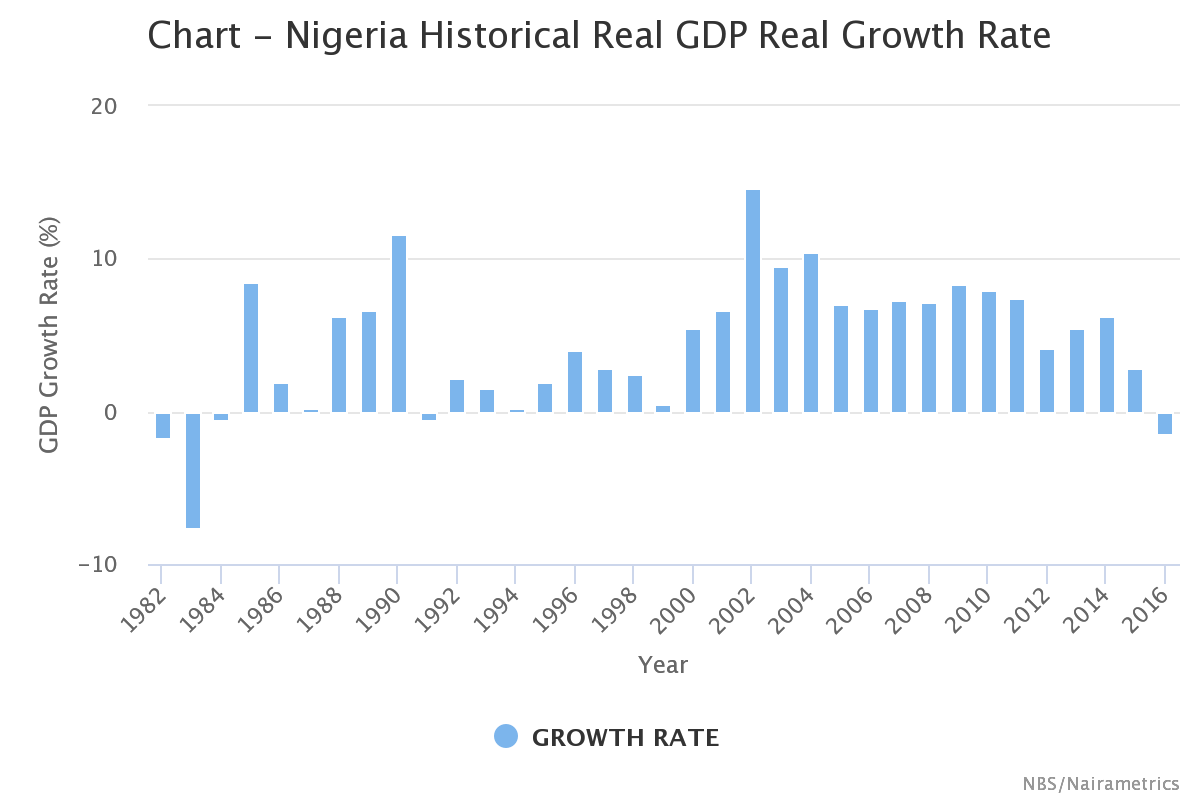Nairametrics| The National Bureau of Statistics on Tuesday, released its 2016 annual GDP numbers, showing and as expected a contraction of about -1.51% for the year ended December 2016. This is Nigeria’s first negative GDP growth rate since 1991, ending a 25 year run of modest GDP Growth rate. Nigeria’s highest GDP growth rate remains 14.6%, recorded in 2006.
[wpdatachart id=10]
NBS Excerpts:
In the fourth quarter of 2016, the nation’s Gross Domestic Product (GDP) contracted by -1.30% (year-on-year) in real terms, from N18,533.75 billion in Q4 2015 to N18,292.95 billion in Q4 2016. This decline was less severe than the decline recorded in the previous quarter, of -2.24%, but was nevertheless lower than the growth rate recorded in the final quarter of 2015, of 2.11% . Quarter on quarter, real GDP increased by 4.09%, which partly reflects seasonal factors as well as a rise in the general price level.
[wpdatachart id=84]
Nigeria’s real GDP is now about N67.9 trillion while nominal GDP is about N94.1 trillion. The NBS did not translate Nigeria’s GDP to dollars making it difficult to determine Nigeria’s GDP compared to other countries.
NBS Excerpts:
Nominal GDP was N29,292,998.54 million at basic prices in the fourth quarter of 2016, which represents year on year nominal growth of 12.97%. In contrast to real growth, this is 5.84% points higher than the rate recorded in the same quarter of 2015, implying that the GDP deflator increased faster than the earlier period. For full year 2016, aggregate nominal GDP stood at N101,598,482.13 compared to N94,144,960.45.
Why the contraction?
According to the NBS, the contraction reflects a difficult year for Nigeria, which included weaker inflation induced consumption demand, an increase in pipeline vandalism, significantly reduced foreign reserves and a concomitantly weaker currency, and problems in the energy sector such as fuel shortages and lower electricity generation
Oil Sector
NBS Excerpts: For the full year 2016, oil production was estimated to be 1.833mb/day, compared to 2.13mb/day in 2015. This reduction has largely been attributed to vandalism in the Niger Delta region. As a result, the sector contracted by -13.65%; a more significant decline than that in 2015 of -5.45%. This reduced the oil sectors share of real GDP to 8.42% in 2016, compared to 9.61% in 2015.
Non-Oil sector
NBS Excerpts: For full year 2016, the non oil sector declined by -0.22% in real terms, compared to a growth rate of 3.75% in 2015, a difference of 3.97% points.
